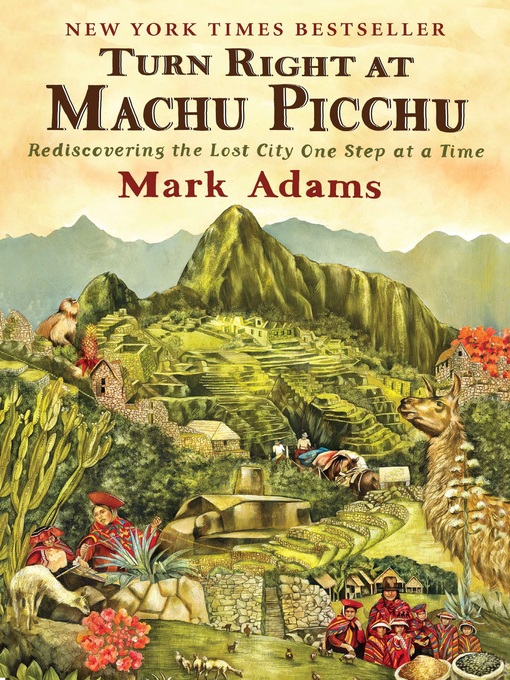
Turn Right at Machu Picchu
Rediscovering the Lost City One Step at a Time
فرمت کتاب
ebook
تاریخ انتشار
2011
نویسنده
Vladimir Naumovنویسنده
John Marinoنویسنده
Vladimir Naumovنویسنده
John Marinoنویسنده
Mark Adamsشابک
9781101535400
کتاب های مرتبط
- اطلاعات
- نقد و بررسی
- دیدگاه کاربران
نقد و بررسی

May 2, 2011
Journalist Adams, whose previous Mr. America was an entertaining rediscovery of the life of early 20th-century fitness guru Bernard Macfadden, explores the weird crevasses of American exploration. In this fascinating history/travelogue, Adams looks at the work of Hiram Bingham III, who became a national sensation after he "discovered" the ancient city of Machu Picchu in July 1911. To celebrate the centennial of Bingham's discovery, Adams attempts to follow Bingham's exact footsteps through the Andes Mountains of Peru, with two clear goals: to figure out "how Bingham had gotten to Machu Picchu in the first place" and, in the face of recent claims that he had illegally smuggled artifacts out of the country, to understand the broader story of Bingham's "all-consuming attempt to solve the mystery of why such a spectacular granite city had been built in such a spellbinding location." Adams successfully weaves Bingham's talesâas well as resuscitating Bingham's positive reputation and accomplishmentsâinto his own description of difficult but often amusing travels with his companions, a rugged Australian survivalist and four local mule tenders, which climaxes with an amazing visual moment that happens only once a year at Machu Picchu on the morning of the winter solstice.

May 1, 2011
Intent on undertaking an audacious open-air exploit, but lacking even rudimentary camping skills or basic gear, an adventure-travel writer recounts his unconventional trek to the mysterious Machu Picchu.
Teamed with an irascible Australian guide and a group of Quechua-speaking mule tenders, Adams (Mr. America: How Muscular Millionaire Bernarr Macfadden Transformed the Nation Through Sex, Salad, and the Ultimate Starvation Diet, 2009) journeyed through the wilds of Peru to unravel the persistent puzzle surrounding the Lost City of the Incas: What was its purpose? The author deftly weaves together two story lines, each peopled with striking characters and astonishing landscapes. Told in alternating chapters, Adams details the life and times of Hiram Bingham III, the outsized early-20th-century explorer credited with "discovering" Machu Picchu, whose reputation has recently suffered due to an archaeological controversy. Overlaid on this extensively researched and entertaining historical framework is the author's humorous recounting of his personal and physical transformation during the demanding trek. Following one extremely strenuous hike, Adams confronted a vacation dilemma. He could either jump on a train or walk another six miles with his 60-pound pack filled with books. "This might be my only chance to hike like a serious adventurer, to carry my own pack like a traveler," he writes, "not heave it onto the luggage rack like a tourist." Coupled with his keen eye for the absurd and his knowledge of the travel industry, the author gleefully remarks on the excesses of the increasingly commercialized adventure-travel business, while never hesitating to point out his own foibles.
A funny, erudite retrospection offering more subtle and lasting rewards than the usual package tour.
(COPYRIGHT (2011) KIRKUS REVIEWS/NIELSEN BUSINESS MEDIA, INC. ALL RIGHTS RESERVED.)

February 15, 2011
On July 24, 1911, Yale professor Hiram Bingham famously stumbled upon Machu Picchu while scaling the Andes. Later he was accused of stealing artifacts and, ultimately, of stealing credit for the find. To get to the truth of the matter, Adams, a travel magazine editor who had never actually slept in a tent, decided on an adventure of his own: he would reconstruct Bingham's trip and reassess what Machu Picchu means today. Sounds like fun with some significant insight; for travel and history fans.
Copyright 2011 Library Journal, LLC Used with permission.

June 1, 2011
This year is the centenary of Hiram Bingham's finding of Machu Picchu, which the Indiana Jones prototype touted as the final Andean redoubt of the Inca. After an editorial career spent sending travel writers to remote corners of the earth, Adams decided to assign himself the adventure of retracing Bingham's steps. Wryly recounting his learning curve of roughing it and getting along with his guide, crusty Australian John Leivers, Adams brings an amusing mixture of credulity and skepticism to his multistrand accounting of Machu Picchuits contemporary look as a crowded tourist attraction; Bingham's theories about the terraced, mountaintop citadel; and subsequent ideas about the ruins fervently advanced by amateur and credentialed archaeologists alike. Weighing Bingham's accounts to figure out exactly what he had achieved (if not exactly discovering Machu Picchu, Bingham sensationally publicized it), Adams fronts the history with entertaining descriptions of his badinage with Leivers about Bingham-associated sites. Retaining its mysterious aura, Machu Picchu will no doubt prove as alluring to modern readers as it did to Bingham. A well-embroidered portrayal.(Reprinted with permission of Booklist, copyright 2011, American Library Association.)

























دیدگاه کاربران